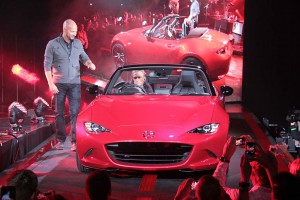European fans will be getting their first close-up look at the all-new Mazda MX-5 Miata as the Paris Motor Show opens its doors this week, but the event brings some news for U.S. roadster aficionados, as well.
The maker left a number of questions unanswered when it staged a three-continent Miata preview party a month back, notably what would be living under the hood. That will depend upon where you live, it turns out.
A number of markets will get the small but scrappy Mazda 1.5-liter inline-four. But all U.S. models will be equipped with the maker’s SkyActiv 2.0-liter gasoline engine, a light, high-output package that should give the new Miata a significant bump in performance.
Should, but Mazda still isn’t offering specifics on either engine package. That, it says, “will be the subject of a future announcement.”
In current applications, the 2.0-liter powertrain makes 155 horsepower. Considering the current Miata already makes 155 horsepower, an educated guess would be that Mazda will find a way to squeeze a bit more out of the SkyActiv package.
The good news is that the next-generation Mazda will weigh in at 2,260 pounds, on average, or 220 pounds less than the outgoing roadster, so even if the pony count stayed flat we might be able to expect a little faster launch times.
(2016 Mazda Miata revealed. For more, Click Here.)
Then again, buyers don’t drive an MX-5 to be the fastest off the line. It’s all about the overall driving experience, something that Mazda has mastered with the Miata.
(Click Here for details about Lambo’s Asterion hybrid concept.)
The new model was developed as part of an unusual joint venture pairing the Japanese maker and Italy’s Fiat, which originally planned to market its version under the Alfa Romeo badge. While few details have been released, the Italian model will now be sold through the Fiat brand.
Going into the development process, Mazda Design Director Derek Jenkins admits he was often quite worried.
(To see the end of an era at Bugatti, Click Here.)
“Go too modern, too radical and we’d risk alienating our core audience,” he said during last month’s unveiling. But, “If we didn’t do enough, we’d risk not reaching a new audience.”
Initial reactions suggest Jenkins and his team struck just the right balance, at least on paper. How the new car actually handles and performs remains to be seen.

